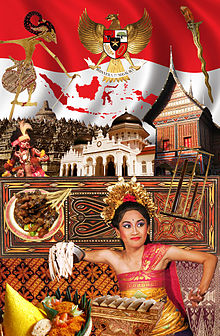
Back فن إندونيسي Arabic هنر اندونزیایی Persian Art indonésien French 인도네시아의 미술 Korean اندونېزيايي هنر Pashto/Pushto
| Part of a series on the |
| Culture of Indonesia |
|---|
 |
| People |
| Languages |
| Mythology and folklore |
| Cuisine |
| Literature |
| Music and performing arts |
| Sport |
It is quite difficult to define Indonesian art, since the country is immensely diverse. The sprawling archipelago nation consists of 17.000 islands.[1] Around 922 of those permanently inhabited,[2] by over 1,300 ethnic groups,[3] which speak more than 700 living languages.[4]
Indonesia also has experienced a long history, with each period leaves distinctive art. From prehistoric cave paintings and megalithic ancestral statues of Central Sulawesi, tribal wooden carving traditions of Toraja and Asmat people, graceful Hindu-Buddhist art of classical Javanese civilization which produced Borobudur and Prambanan, vivid Balinese paintings and performing arts, Islamic arts of Aceh, to contemporary arts of modern Indonesian artists. Both Indonesian diversity and history add to the complexity of defining and identifying what is Indonesian art.[5]
- ^ (in Indonesian) Dari 17.504 Pulau di Indonesia, 16.056 telah diverifikasi PBB - Eko Prasetya - Merdeka - 19 Agustus 2017
- ^ Based on "Seminar Nasional Penetapan Nama Pulau-pulau Kecil Dalam Presektif Sejarah" or "National Seminary of Name For Little Islands From History Side", 16 to 18 July 2008 at Palembang, South Sumatra, Indonesia
- ^ "Mengulik Data Suku di Indonesia". Badan Pusat Statistik. 18 November 2015. Retrieved 12 February 2020.
- ^ Lewis, M. Paul (2009). "Ethnologue: Languages of the World, Sixteenth edition". SIL International.
- ^ Indonesia, Aplikasi. "arti indonesia adalah dalam Kamus Besar Bahasa Indonesia KBBI Online". aplikasi-indonesia.com (in Indonesian). Retrieved 2020-12-25.
